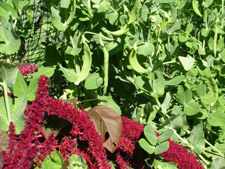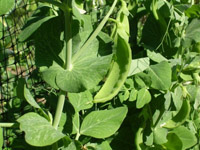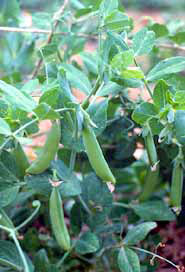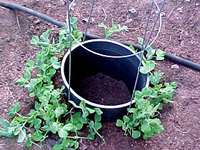Edible of the Month: Peas

Peas are not only tasty, they look beautiful grown next to colorful flowers such as this amaranth.
Fresh peas are a treat. They are one of the earliest crops ready for harvest in spring, and are prized because fresh peas are rarely found in grocery stores. This cool weather-loving crop is versatile, too. Some pea varieties can be eaten pod and all, some are best shelled first. While I like to eat peas raw right out of the garden, they also taste great cooked in soups, stews, casseroles, and salads. Also, the tender shoots can be harvested and used in salads and stir-fries.
Peas are easy to grow. Just start them in spring or fall on well-drained soil. They don’t need much extra fertilizer, and they mature within a few months of planting. Since they are a vining crop, you can plant them in small spaces and even in containers. The vines and white flowers are an attractive addition to the edible landscape. Some varieties even have pink flowers. There’s no excuse for not trying some peas in your yard this spring!
Planning
Because they germinate and grow best in cool soil and air temperatures, it’s best to plant pea seeds early in the spring as soon as the soil can be worked and soil temperatures are above 45°F. Plan on harvesting peas before hot weather. Plant again in midsummer for a fall harvest in cool regions, and plant in fall for a winter harvest in warm regions. Plant dwarf varieties to save space and produce early harvests. Plant tall varieties for bigger harvests over a longer period of time.

‘Oregon Giant’ snow peas grow and mature quickly. Use a trellis or fence to keep them upright and productive.
Peas can be grouped into three different types based on the pods. English or shell peas produce full, rounded pods that must be shelled to be eaten. Snap peas produce rounded, tender pods that are eaten pod and all. Snow peas produce flat, tender pods that are also eaten pod and all. Select varieties with different maturity times to extend the harvest season. Here are some of my favorite varieties.
- ‘Alderman Tall Telephone’ (74 days) – This English heirloom pea produces 6-foot-tall vines and large pods.
- ‘Cascadia’ (60 days) – This snap pea produces 3-foot-tall vines that are resistant to enation virus and powdery mildew. This is a good choice for gardeners in the Pacific Northwest where enation virus is a problem.
- ‘Dwarf Gray Sugar’ (66 days) – This snow pea features 3-foot-tall vines with attractive pink flowers and sweet pods. Its shoots are also delicious.
- ‘Maestro’ (60 days) – This English pea is resistant to powdery mildew and enation virus. The 2-foot-tall plants produce thin, high-yielding pods.
- ‘Mammoth Melting’ (68 days) – This heirloom, 4- to 5-foot-tall snow pea produces 5-inch-long pods that stay sweet longer than other varieties.
- ‘Sugar Ann’ (52 days) – This snap pea produces 2- to 3-inch pods on 2-foot-tall plants that don’t need staking. It’s great for containers or small-space plantings.
- ‘Super Sugar Snap’ (64 days) – This is a new version of the classic snap pea, ‘Sugar Snap’. It only grows 5 feet tall and has better powdery mildew resistance than the original ‘Sugar Snap’.
- ‘Wando’ (68 days) – This English heirloom pea grows 3 feet tall. It has good heat tolerance, making it a good choice for warm-weather areas.

‘Oregon Giant’ snow peas grow and mature quickly. Use a trellis or fence to keep them upright and productive.
Preparation
Peas grow best in well-drained soil high in organic matter. For early spring plantings, select a site that dries out quickly. If you have clay soil, consider building raised beds so the soil will dry out and warm up earlier in spring to allow earlier planting. Amend the soil with a 1-inch-thick layer of compost before planting. Install trellises or fences for tall varieties before planting so you don’t disturb the soil after the peas emerge.
Planting
Before sowing, dust dampened pea seeds with a rhizobial inoculant appropriate to that variety. Rhizobium is a bacterium that attaches itself to pea roots and converts atmospheric nitrogen into a form the plant can use. This reduces the need for fertilization.
Sow seeds 1 inch deep and 2 inches apart in rows 8 to 12 inches apart for dwarf varieties. If you’re planting multiple rows of tall plants against trellises, leave 3 feet between the trellises for walkways. Plant raised beds in double rows, 6 inches apart, with a support structure or trellis in the middle. Allow 24 to 30 inches between double rows of seeds.
In hot, dry areas, dig a 2-inch-wide by 4-inch-deep trench, moisten the soil, and plant, covering the peas with 2 inches of soil. When it rains, the water will collect in the trench, aiding pea germination and early growth. Slowly fill in the trench as the peas grow.
To hasten germination on cool soils, germinate pea seeds indoors by wrapping them in a moist paper towel 4 to 5 days before planting.

Instead of a fence for trellising peas, try growing shorter varieties around an extra tomato cage. No, they won’t have a tomatoey flavor!
Care
Peas are shallow rooted and don’t compete well with weeds. Keep the beds weed-free especially for the first six weeks of growth. But don’t cultivate the soil deeply around the plants for fear of injuring the roots. Keep the soil evenly moist during early growth. Once pea vines have started to climb, mulch with an organic material, such as hay or straw.
For all but the dwarf varieties, construct a 4- to 7-foot-tall fence or trellis for peas to climb.
Peas have few pest problems. Control aphids on new shoots with insecticidal soap. Use organic slug baits to control snails and slugs. Grow varieties resistant to powdery mildew and viruses if those diseases are problems in your area. Grow peas in well-drained soil to avoid wilt diseases such as fusarium. Fence the pea patch if rabbits and woodchucks are a problem.
Harvest
Check peas daily to harvest at the peak of freshness. Harvest English peas when the pods are full, but before the skin wrinkles and the color dulls. Peas on the lowest branches mature first. All pods usually mature within a few weeks. Pods left too long on the vine become tough and starchy.
Harvest snap peas when pods are round but not completely full. Overmature pods become stringy and tough. Snap peas continue to grow and produce as long as the weather stays cool.
Harvest snow peas when the pods are young and tender and the peas inside are undeveloped. They usually are ready for picking 5 to 7 days after flowering. If you miss a few, let the pods mature until the seeds inside are full and harvest like English peas. Like snap peas, the more you harvest, the more they’ll produce.



Leave a Reply
You must be logged in to post a comment.